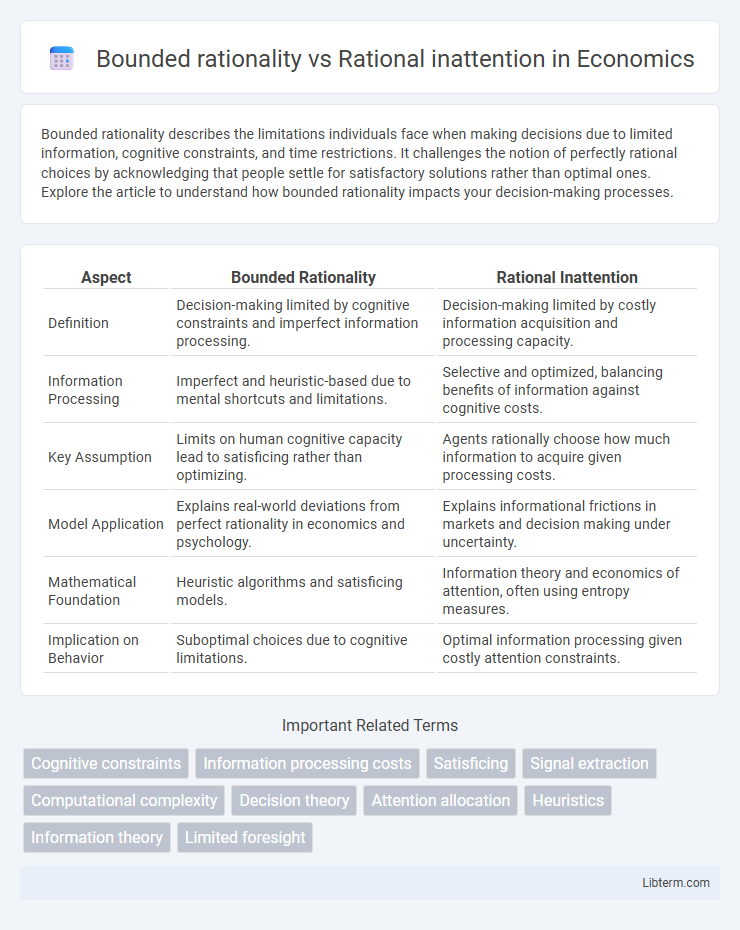Bounded rationality describes the limitations individuals face when making decisions due to limited information, cognitive constraints, and time restrictions. It challenges the notion of perfectly rational choices by acknowledging that people settle for satisfactory solutions rather than optimal ones. Explore the article to understand how bounded rationality impacts your decision-making processes.
Table of Comparison
| Aspect | Bounded Rationality | Rational Inattention |
|---|---|---|
| Definition | Decision-making limited by cognitive constraints and imperfect information processing. | Decision-making limited by costly information acquisition and processing capacity. |
| Information Processing | Imperfect and heuristic-based due to mental shortcuts and limitations. | Selective and optimized, balancing benefits of information against cognitive costs. |
| Key Assumption | Limits on human cognitive capacity lead to satisficing rather than optimizing. | Agents rationally choose how much information to acquire given processing costs. |
| Model Application | Explains real-world deviations from perfect rationality in economics and psychology. | Explains informational frictions in markets and decision making under uncertainty. |
| Mathematical Foundation | Heuristic algorithms and satisficing models. | Information theory and economics of attention, often using entropy measures. |
| Implication on Behavior | Suboptimal choices due to cognitive limitations. | Optimal information processing given costly attention constraints. |
Introduction to Bounded Rationality and Rational Inattention
Bounded rationality describes decision-making processes where cognitive limitations and limited information processing capacity constrain individuals, leading to satisficing rather than optimizing behavior. Rational inattention theory extends this concept by modeling how agents optimally allocate limited attention resources to process information selectively, balancing the cost of acquiring information against potential benefits. Both frameworks challenge classical rationality assumptions by incorporating realistic cognitive and informational constraints within economic and behavioral models.
Defining Bounded Rationality: Key Concepts
Bounded rationality refers to the cognitive limitation of decision-makers who operate under constraints of limited information, time, and computational capacity, resulting in satisficing rather than optimizing choices. It emphasizes the pragmatic approach individuals use to make decisions by simplifying complex problems and relying on heuristics, rather than seeking perfect solutions. This concept contrasts with rational inattention by highlighting the inherent limits in processing information rather than deliberate information neglect.
What Is Rational Inattention?
Rational inattention refers to the cognitive limitation framework where decision-makers optimally allocate their limited attention to process information most relevant for making choices, recognizing that acquiring and processing information entails costs. Unlike bounded rationality, which emphasizes cognitive constraints leading to satisficing behavior, rational inattention models behavior assuming rational agents who deliberately ignore some information to maximize utility given attention costs. This concept is crucial in economics and behavioral decision theory for understanding information processing under constraints and its impact on economic choices and market dynamics.
Comparing Cognitive Limitations and Information Processing
Bounded rationality highlights cognitive limitations by emphasizing decision-makers' inability to process all available information due to constraints in attention, memory, and computational capacity. Rational inattention models explicitly quantify the cost of acquiring and processing information, suggesting agents optimally allocate limited cognitive resources to maximize decision efficiency. Both theories address information processing constraints but differ in that bounded rationality focuses on heuristics and satisficing behavior, while rational inattention uses information theory to formalize attention allocation under cognitive costs.
Decision-Making Models: Bounded vs Inattentive
Bounded rationality emphasizes decision-making limitations due to cognitive constraints and incomplete information processing, leading individuals to use heuristics and satisficing rather than optimizing. Rational inattention, on the other hand, models decision-making where individuals optimally allocate limited attention to process information, balancing the cost of acquiring data against expected benefits. Both frameworks critique classical rationality by incorporating real-world constraints but differ in their treatment of cognitive limits versus deliberate information-filtering strategies.
Economic Applications of Both Concepts
Bounded rationality models economic agents who satisfice within cognitive limitations, influencing consumer choice, labor market behavior, and firm decision-making under uncertainty. Rational inattention explains the allocation of limited attention due to information acquisition costs, impacting financial market volatility, monetary policy effectiveness, and consumer demand responsiveness. Both frameworks enhance economic modeling by incorporating realistic cognitive constraints into predictions of market outcomes and policy analyses.
Behavioral Impacts on Market Outcomes
Bounded rationality limits decision-making by constraining cognitive resources, causing individuals to rely on heuristics that can lead to suboptimal market outcomes like pricing inefficiencies and misallocation of resources. Rational inattention, characterized by selective information processing due to limited attention capacity, affects how agents respond to market signals, resulting in delayed adjustments and volatility in asset prices. Both behavioral mechanisms highlight departures from fully rational models, influencing market dynamics through information frictions and bounded cognitive processing.
Empirical Evidence: Studies and Experiments
Empirical evidence comparing bounded rationality and rational inattention highlights distinct decision-making processes under cognitive constraints. Studies such as Sims (2003) demonstrate that rational inattention models better capture agents' information processing limits by quantifying attention costs, whereas experiments on bounded rationality by Simon (1957) emphasize heuristic-driven behavior under complexity. Experimental data from dynamic choice tasks reveal that rational inattention frameworks more accurately predict choices when attention allocation varies, while bounded rationality explains satisficing behavior in environments with overwhelming information.
Critiques and Limitations of Each Theory
Bounded rationality faces critiques regarding its often vague definition of cognitive limits, making precise modeling difficult, while it tends to underestimate individuals' adaptive strategies in complex decision-making. Rational inattention's limitations arise from its assumption that information processing costs are quantifiable and consistent across contexts, which can oversimplify human cognitive diversity and environmental variability. Both theories struggle to fully account for the dynamic interplay between cognitive constraints and information acquisition in real-world economic behavior.
Implications for Future Research and Policy
Bounded rationality emphasizes cognitive limitations affecting decision-making processes, suggesting future research should explore adaptive heuristics and simplified models for policy design. Rational inattention highlights information-processing constraints, indicating the need for policies accounting for selective information acquisition and attention allocation. Integrating these frameworks can improve predictive accuracy in economic behavior and optimize interventions in complex environments.
Bounded rationality Infographic

 libterm.com
libterm.com